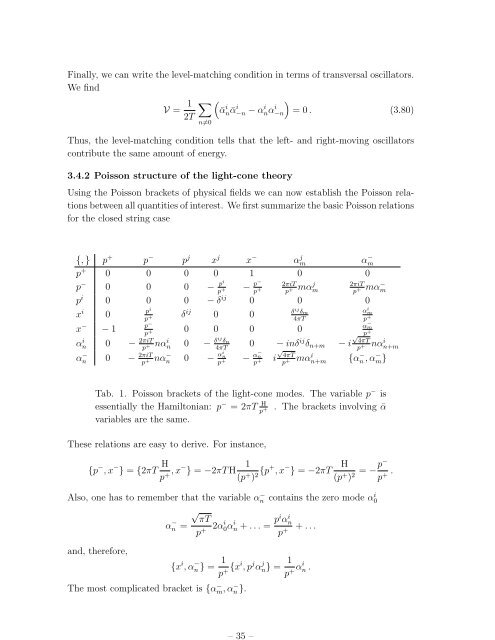Lectures on String Theory
Lectures on String Theory
Lectures on String Theory
You also want an ePaper? Increase the reach of your titles
YUMPU automatically turns print PDFs into web optimized ePapers that Google loves.
– 35 –<br />
Finally, we can write the level-matching c<strong>on</strong>diti<strong>on</strong> in terms of transversal oscillators.<br />
We find<br />
V = 1 ∑ (<br />
)<br />
ᾱ i<br />
2T<br />
nᾱ−n i − αnα i −n<br />
i = 0 . (3.80)<br />
n≠0<br />
Thus, the level-matching c<strong>on</strong>diti<strong>on</strong> tells that the left- and right-moving oscillators<br />
c<strong>on</strong>tribute the same amount of energy.<br />
3.4.2 Poiss<strong>on</strong> structure of the light-c<strong>on</strong>e theory<br />
Using the Poiss<strong>on</strong> brackets of physical fields we can now establish the Poiss<strong>on</strong> relati<strong>on</strong>s<br />
between all quantities of interest. We first summarize the basic Poiss<strong>on</strong> relati<strong>on</strong>s<br />
for the closed string case<br />
{, } p + p − p j x j x − αm j αm<br />
−<br />
p + 0 0 0 0 1 0 0<br />
p − 0 0 0 − pi<br />
− p− 2πiT<br />
mα j 2πiT<br />
p + p + p + m mα − p + m<br />
p i 0 0 0 − δ ij 0 0 0<br />
x i 0<br />
x − − 1<br />
p i<br />
δ ij δ<br />
0 0 ij δ m<br />
p + 4πT<br />
p −<br />
0 0 0 0<br />
p +<br />
α i n 0 − 2πiT<br />
p + nα i n 0 − δij δ n<br />
αn − 0 − 2πiT nα − p + n 0 − αi n<br />
p +<br />
4πT<br />
0 − inδ ij δ n+m − i √ 4πT<br />
− α− n<br />
p +<br />
α i m<br />
p +<br />
α − m<br />
p +<br />
nα i p + n+m<br />
i √ 4πT<br />
p + mα i n+m {α − n , α − m}<br />
Tab. 1. Poiss<strong>on</strong> brackets of the light-c<strong>on</strong>e modes. The variable p − is<br />
essentially the Hamilt<strong>on</strong>ian: p − = 2πT H . The brackets involving ᾱ<br />
p +<br />
variables are the same.<br />
These relati<strong>on</strong>s are easy to derive. For instance,<br />
{p − , x − } = {2πT H p + , x− } = −2πT H 1<br />
(p + ) 2 {p+ , x − } = −2πT H<br />
(p + ) 2 = −p− p + .<br />
Also, <strong>on</strong>e has to remember that the variable α − n c<strong>on</strong>tains the zero mode α i 0<br />
α − n =<br />
√<br />
πT<br />
p +<br />
2αi 0α i n + . . . = pi α i n<br />
p + + . . .<br />
and, therefore,<br />
{x i , α − n } = 1<br />
p + {xi , p j α j n} = 1<br />
p + αi n .<br />
The most complicated bracket is {α − m, α − n }.

















